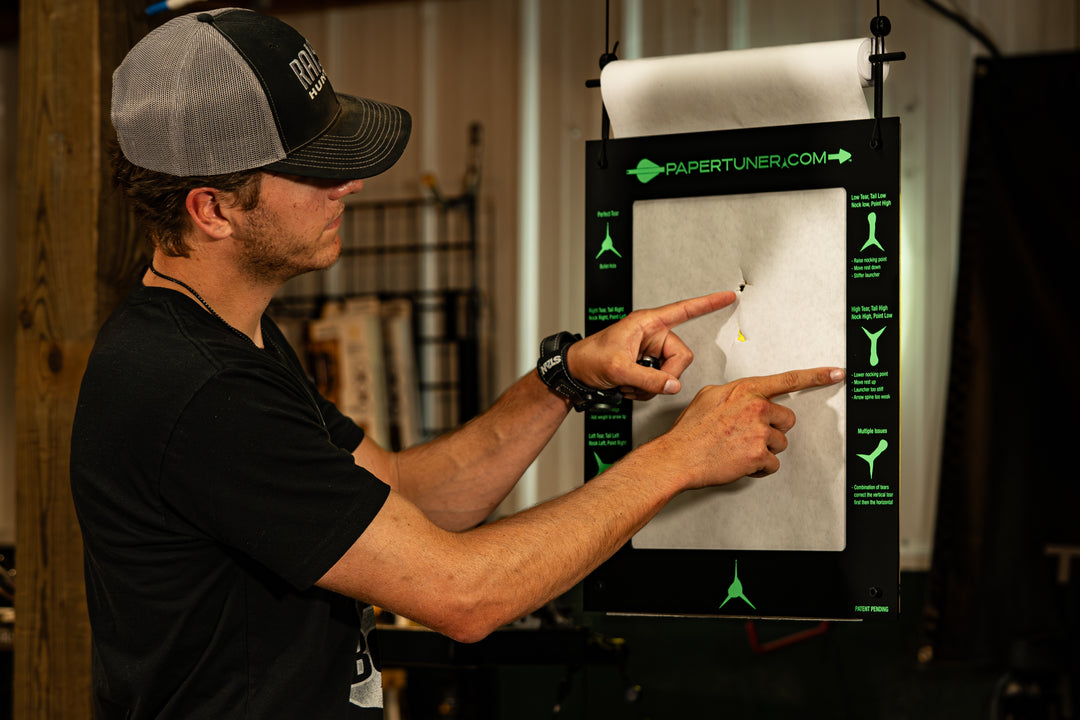How To's
How To Set Up Your Hang & Shoot Paper Tuner
How to tune your bow
BARE SHAFT TUNING
Bare Shaft Tuning involves shooting a bare shaft arrow (no fletchings/vanes) alongside your regular fletched arrows at a target. Since bare shafts have no steering correction from vanes, they show the true flight path coming out of the bow. If the bow and arrows are tuned well, the bare shafts will impact close to the fletched shafts.
- Prepare Arrows
• Take 1–2 arrows and carefully strip off the vanes (keep nock and point).
• Use the same shaft model, spine, length, and point weight as your fletched arrows. - Start Close (10–15 yards)
• Shoot 2–3 fletched arrows, then a bare shaft.
• Compare where they land. - Evaluate Results
• Perfect Tune: Bare shaft and fletched shafts group together.
• Weak Spine / Nock Left (RH Archer): Bare shaft lands left of fletched.
• Stiff Spine / Nock Right (RH Archer): Bare shaft lands right of fletched.
• High/low differences may indicate nocking point issues.
Note: Reverse left/right if you’re a left-handed archer. - Adjust
• Rest position (small left/right adjustments).
• Nocking point (raise/lower).
• Arrow spine/point weight if issues persist. - Confirm at Longer Range
• Once grouping well at 10–15 yards, repeat at 20–30 yards.
• Small differences will be amplified at distance, so this confirms tune.
WALK BACK TUNING
Walk Back Tuning is an archery bow tuning method that helps you verify whether your arrow rest (or center shot) is set correctly so that arrows are leaving the bow in line with the string.
- Start Close to the Target
• Set up a large target with a vertical line (like tape or a drawn plumb line).
• Stand close (about 5–10 yards) and aim at the line.
• Adjust your sight so your arrows hit the line. - Walk Back in Distance
• Without changing your sight, step back farther (20, 30, 40+ yards).
• Keep aiming at the same vertical line at the target.
• Shoot arrows at each distance. - Observe Arrow Groups
• If the bow is tuned properly, all arrows—regardless of distance—will impact along the vertical line.
• If arrows drift left or right as you go back, it means the rest alignment (center shot) is slightly off. - Make Adjustments
• Move the arrow rest very slightly left or right until arrows group in a straight vertical line at all distances.
Broadhead Tuning
Broadhead tuning is shooting broadheads and field points side by side, then micro-adjusting your rest until both group together
Why Broadhead Tuning Is Needed
- Field points are aerodynamically forgiving; vanes easily correct them.
- Broadheads (especially fixed blade) act like “wings” and magnify small tuning errors.
- Even a slightly misaligned rest, spine mismatch, or torque can cause broadheads to group several inches away from field points.
Step-by-Step Broadhead Tuning
1. Prep Your Arrows
- Use the same shafts for field points and broadheads (identical spine, length, weight).
- Spin test broadheads on a flat surface to ensure they’re perfectly straight.
- Start with fixed blade broadheads if possible (more sensitive, better for tuning).
2. Start Close
- Stand at 20 yards.
- Shoot a group of field points (2–3 arrows).
- Shoot a group of broadheads (2–3 arrows).
3. Compare Groups
- If tuned well → broadheads and field points group together.
- If broadheads impact differently, note the direction.
4. Make Micro Adjustments
- Move rest in 1/32″ to 1/16″ increments only.
- Re-shoot both groups after each change.
- Continue until broadheads and field points share the same group.
5. Step Back Further
- Confirm at 30–40 yards (and 50+ if you’re comfortable).
- At longer distances, small errors are amplified, so this verifies true tune.



